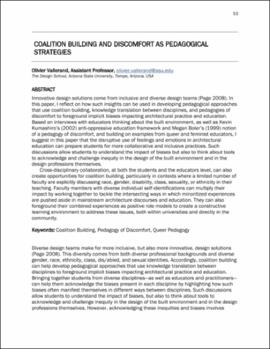| dc.contributor.author | Vallerand, Olivier | |
| dc.date.accessioned | 2022-03-23T20:45:03Z | |
| dc.date.available | 2022-03-23T20:45:03Z | |
| dc.date.issued | 2022 | |
| dc.identifier.citation | Vallerand, Olivier, "Coalition Building and Discomfort as Pedagogical Strategies," in Person, Angela M., Anthony Cricchio, and Stephanie Z. Pilat, eds. 2022. Proceedings of Schools of Thought: Rethinking Architectural Pedagogy, Norman, Oklahoma, March 5-7, 2020. University of Oklahoma Libraries: ShareOK. | |
| dc.identifier.uri | https://hdl.handle.net/11244/335079 | |
| dc.description | This paper was presented at the 2020 Schools of Thought Conference hosted by the Christopher C. Gibbs College of Architecture at the University of Oklahoma. | |
| dc.description.abstract | Innovative design solutions come from inclusive and diverse design teams (Page 2008). In this paper, I reflect on how such insights can be used in developing pedagogical approaches that use coalition building, knowledge translation between disciplines, and pedagogies of discomfort to foreground implicit biases impacting architectural practice and education. Based on interviews with educators thinking about the built environment, as well as Kevin Kumashiro’s (2002) anti-oppressive education framework and Megan Boler’s (1999) notion of a pedagogy of discomfort, and building on examples from queer and feminist educators, I suggest in this paper that the disruptive use of feelings and emotions in architectural education can prepare students for more collaborative and inclusive practices. Such discussions allow students to understand the impact of biases but also to think about tools to acknowledge and challenge inequity in the design of the built environment and in the design professions themselves. Cross-disciplinary collaboration, at both the students and the educators level, can also create opportunities for coalition building, particularly in contexts where a limited number of faculty are explicitly discussing race, gender, disability, class, sexuality, or ethnicity in their teaching. Faculty members with diverse individual self-identifications can multiply their impact by working together to tackle the intersecting ways in which minoritized experiences are pushed aside in mainstream architecture discourses and education. They can also foreground their combined experiences as positive role models to create a constructive learning environment to address these issues, both within universities and directly in the community. | |
| dc.description.sponsorship | Research for this project was funded in part through a postdoctoral fellowship from the Fonds de recherche du Québec—Société et culture,under Grant [198091]. | |
| dc.language.iso | en_US | |
| dc.relation.ispartof | 2020 Schools of Thought Conference | |
| dc.relation.uri | https://hdl.handle.net/11244/335058 | |
| dc.rights | CC BY-NC-SA | |
| dc.rights.uri | https://creativecommons.org/licenses/by-nc-sa/4.0/ | |
| dc.subject | coalition building | |
| dc.subject | pedagogy of discomfort | |
| dc.subject | queer pedagogy | |
| dc.subject | architectural education | |
| dc.title | Coalition Building and Discomfort as Pedagogical Strategies | |
| dc.type | Article | |
| dc.description.peerreview | Yes | |
| dc.identifier.doi | 10.15763/11244/335079 | |
| ou.group | Christopher C. Gibbs College of Architecture | |


